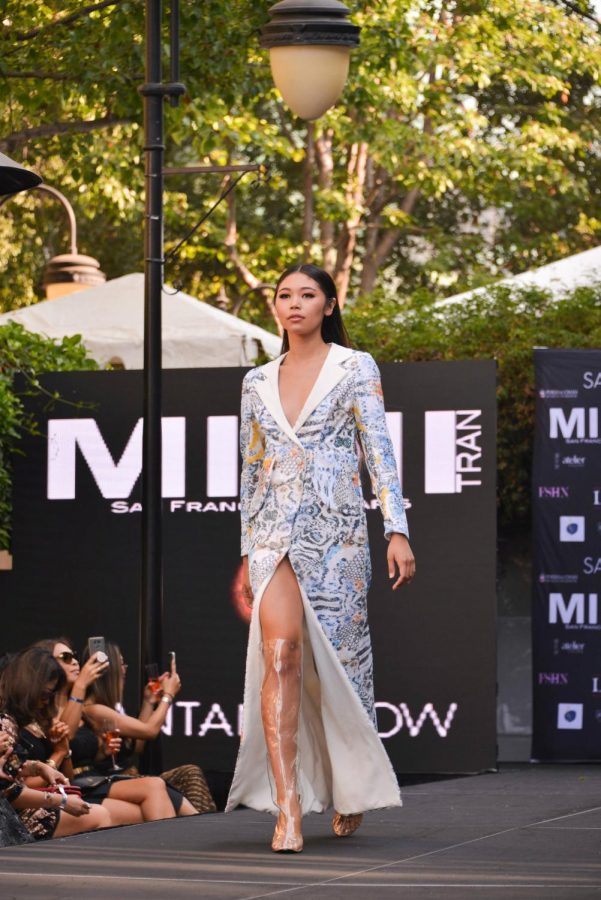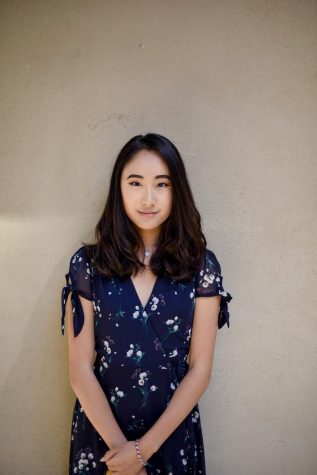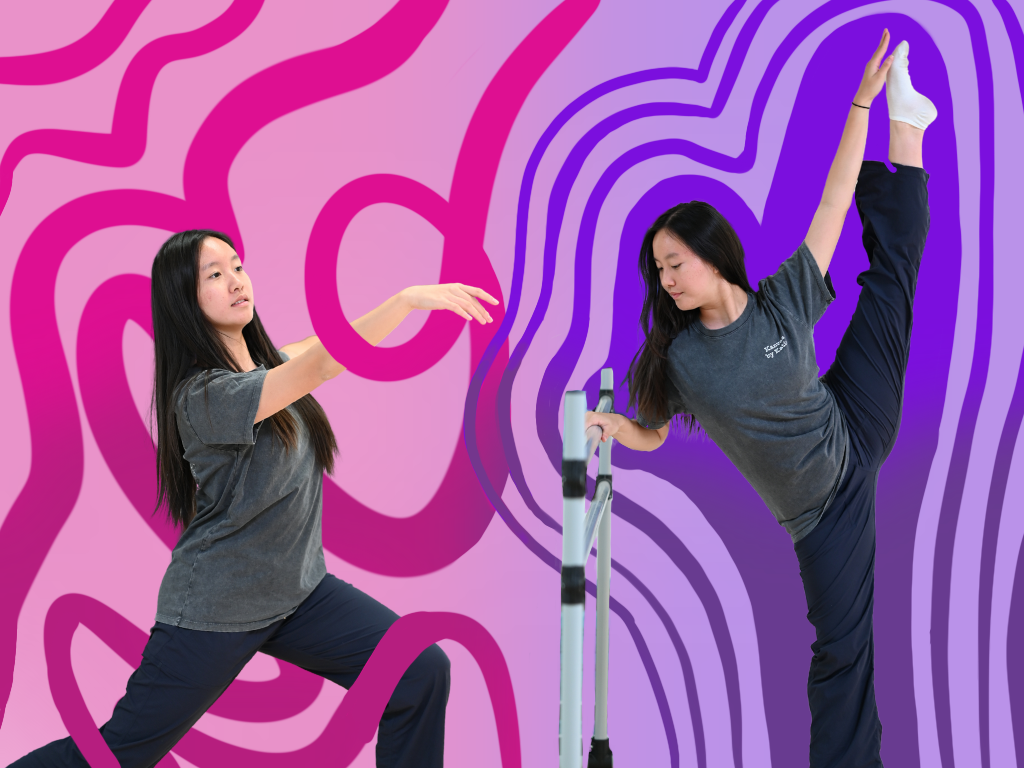So you wanna be a fashion designer?
Designer Mimi Tran, center, poses after her fashion show on Aug. 25.
September 3, 2018
Mimi Tran’s journey to becoming a fashion designer began when she was barely old enough to form sentences. Now, she owns a store in Santana Row and works with the stylists of celebrities like Lady Gaga, Camila Cabello, Little Mix, Carrie Underwood and more.
Even at a young age, Mimi displayed unique talent and the potential to become a remarkable artist. After moving from Vietnam, her birthplace, to Paris at six years old, she began to develop an interest in visual arts and fashion. There, she attended a boarding school that offered sewing classes, an early start to her future as a fashion designer. At nine, she received a scholarship for the arts in Paris.
“My mom mentioned five years ago at my first fashion show that my dream was to become a fashion designer and travel the world… even when I was younger, when I didn’t remember anything. And then, I actually realized when I was seven that I have an artistic mind,” she said.
However, following her father’s advice, Mimi later set aside her interest in fashion and the arts to pursue a more stable, predictable career. She and her family moved to the United States when she was 15, and she later received degrees for electrical engineering and marketing from a state university. After years of working as an engineer for Cisco and later in finance at Wells Fargo, she finally decided to return to fashion. Since then, she has had no regrets.
“I went online and studied everything I need to know about fashion—I studied all the top designers in the world now and what their signatures are,” she said. “It worked out for me. If I had started out as a fashion designer way before I had the engineering and business degrees, I would’ve never been able to do it. I think because I went through all that, it got me where I am today.”
To Mimi, her passion for fashion connects directly with her innate roots as an artist. Following the example of top designers such as Dior, Versace, Chanel and Louis Vuitton, she draws all of her designs by hand and carefully deliberates over each and every detail in her designs.
“I don’t use computers because I think they’re very limited […] because it’s not just important to being a fashion designer that you know how to draw, but also that you have an eye for color and texture,” she said. “Every season, you have thousands of different laces, textures and colors. You have to have a gift—you look at all those fabrics and pick one or two or three that you know are going to match.”
Mimi has added sparks of her own character to her love for fashion design to craft a brand signature: hand-beaded sequin flowers. Her brand signature was the brainchild of late-night problem solving when trying to design custom outfits for country singer Kelsea Ballerini’s first tour. Now, they represent her own quirkiness and evolution from self-proclaimed high school “geek” to confident woman.
As a result of her own past experiences, she works to also spread a message of empowerment through her fashion—not just in the product, but also in the process.
“What I call the ‘Mimi woman’ is a woman who knows what she wants, and nothing scares her from going to get what she wants,” Mimi said. “My dresses are designed for the body; I don’t just put the body in the dress. I work with many different types of bodies, but I always make sure that whatever I design for the particular person fits right in with her personality and body type. That’s the way to feel confident.”
Despite being able to both expand the scale of her art and spread a positive message, Mimi feels that building a label as a professional fashion designer sometimes limits her capability.
“I always break the rules and design whatever comes to me. Different seasons have different designs,” she said. “But I wish I could do more, just with my artistic side and not based so much in the market… Being an artist is great, but you have to make sure your art sells to sustain your business.”
Looking ahead, Mimi hopes that one day she can freely develop her style—flairs of color and fresh designs merged with traditional cuts and classic silhouettes—and that the challenges she currently faces will not prevent her from reaching her ultimate dream: to leave her mark on the world.
“I hope I can make enough [money] to give me the opportunity to just contribute to the fashion world, because I think I have a gift,” Mimi said. “I hope when I’m on my dying bed, I can look up to my grandkids and say, ‘Hey, I did it. I contributed to this generation, this decade. I’ve changed fashion.’”
This piece was originally published in the pages of The Winged Post on Aug. 31, 2018.


















![“[Building nerf blasters] became this outlet of creativity for me that hasn't been matched by anything else. The process [of] making a build complete to your desire is such a painstakingly difficult process, but I've had to learn from [the skills needed from] soldering to proper painting. There's so many different options for everything, if you think about it, it exists. The best part is [that] if it doesn't exist, you can build it yourself," Ishaan Parate said.](https://harkeraquila.com/wp-content/uploads/2022/08/DSC_8149-900x604.jpg)




![“When I came into high school, I was ready to be a follower. But DECA was a game changer for me. It helped me overcome my fear of public speaking, and it's played such a major role in who I've become today. To be able to successfully lead a chapter of 150 students, an officer team and be one of the upperclassmen I once really admired is something I'm [really] proud of,” Anvitha Tummala ('21) said.](https://harkeraquila.com/wp-content/uploads/2021/07/Screen-Shot-2021-07-25-at-9.50.05-AM-900x594.png)







![“I think getting up in the morning and having a sense of purpose [is exciting]. I think without a certain amount of drive, life is kind of obsolete and mundane, and I think having that every single day is what makes each day unique and kind of makes life exciting,” Neymika Jain (12) said.](https://harkeraquila.com/wp-content/uploads/2017/06/Screen-Shot-2017-06-03-at-4.54.16-PM.png)








![“My slogan is ‘slow feet, don’t eat, and I’m hungry.’ You need to run fast to get where you are–you aren't going to get those championships if you aren't fast,” Angel Cervantes (12) said. “I want to do well in school on my tests and in track and win championships for my team. I live by that, [and] I can do that anywhere: in the classroom or on the field.”](https://harkeraquila.com/wp-content/uploads/2018/06/DSC5146-900x601.jpg)
![“[Volleyball has] taught me how to fall correctly, and another thing it taught is that you don’t have to be the best at something to be good at it. If you just hit the ball in a smart way, then it still scores points and you’re good at it. You could be a background player and still make a much bigger impact on the team than you would think,” Anya Gert (’20) said.](https://harkeraquila.com/wp-content/uploads/2020/06/AnnaGert_JinTuan_HoHPhotoEdited-600x900.jpeg)

![“I'm not nearly there yet, but [my confidence has] definitely been getting better since I was pretty shy and timid coming into Harker my freshman year. I know that there's a lot of people that are really confident in what they do, and I really admire them. Everyone's so driven and that has really pushed me to kind of try to find my own place in high school and be more confident,” Alyssa Huang (’20) said.](https://harkeraquila.com/wp-content/uploads/2020/06/AlyssaHuang_EmilyChen_HoHPhoto-900x749.jpeg)












